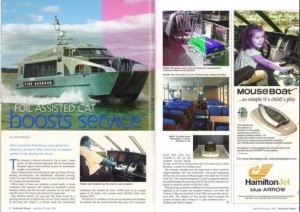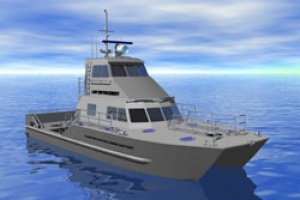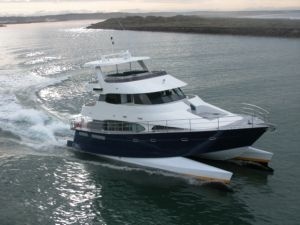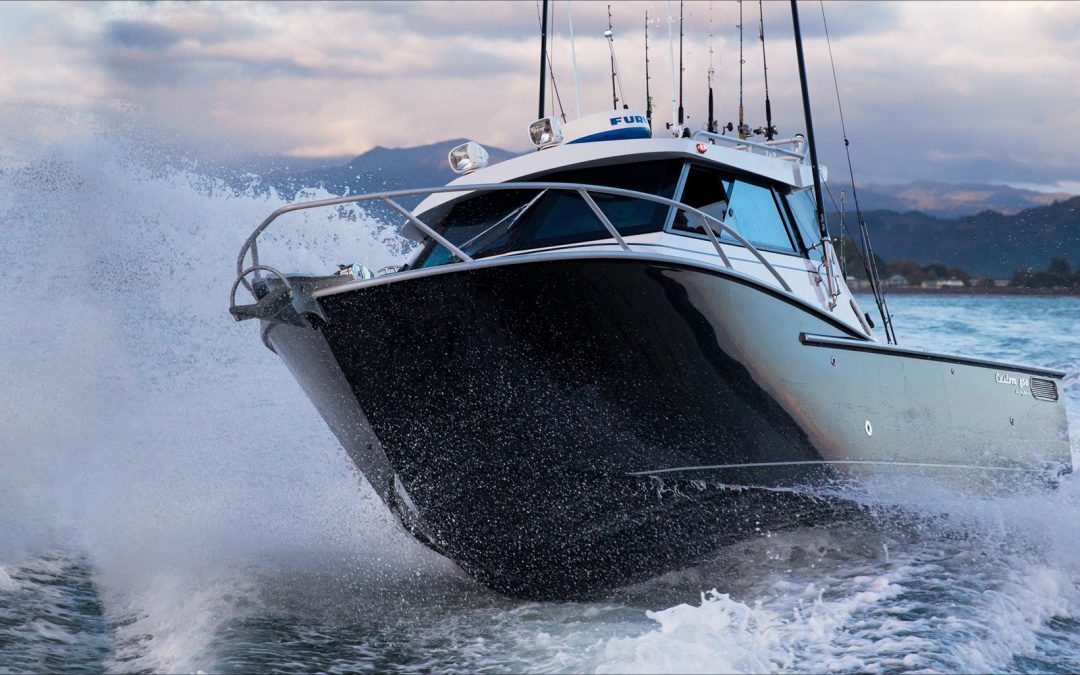
CLIPPER II ARTICLE
S53 Clipper II
Foil assisted cat boosts service
by Keith Ingram
When Auckland’s Pine Harbour ferry service first started on January 6, 2002, there was no transport subsidy to help develop this service.
The company’s directors decided to “go it alone”, based purely on their acknowledgement that the Beachlands-Maraetai region would continue to grow as Aucklanders sought a rural lifestyle.
Many lifestyle blocks were starting to open up, along with new housing developments, and Beachlands’ affordable housing, which was once the best-kept secret in town, became the target for younger first homeowners.
While many of these new residents worked locally in South Auckland, their partners still worked in Auckland’s central business district, and the hour-plus commute by car each way took the shine off living in this little bit of countryside.
Pine Harbour Ferries Ltd was sure that there would be a growing demand for a regular ferry service. Since January 2002, its first ferry, the Clipper I, a 49-seat small, fast foil-assisted catamaran, has clocked up some 14,000 hours at an average speed of 26 knots, and covered some 224,000 miles since January 2002.
The director’s confidence in the service has been well founded. So popular has the service become that some 220 commuters travel daily each way. Coupled to this are the shoppers’ services during the day. At $76 for a 10-trip ticket and a 35-minute trip in either direction, it makes for sensible travel.
The company decided from the outset that its ferry would be skipper-operated, fast and comfortable, with good seakeeping ability and a maximum of 49 passengers. You might say it’s a fast water bus. The Auckland Regional Council’s transport authority has acknowledged the growing need for the service, and has now applied a transport subsidy to the ferry route.
With growing commuter confidence in a ferry service that sails regularly in all weather, the company ordered a new ferry, the Clipper II. She was launched in June 2006 and went into service soon after. The addition of this second vessel increased the number of return daily sailings to 11, plus weekend trips to Waiheke and Rakino Islands.
The Clipper II is significantly larger in volume and size than the Clipper I, although both carry the same number of passengers and are crewed by one person. At 2m longer and 1.5m wider, the additional volume gives greater passenger comfort and additional seakeeping ability. She was designed by Nic de Waal, who also designed the Clipper I, but she uses an adjustable foil to assist her lift.
As we move through the vessel, we proceed through the for’ard watertight bulkhead door onto the foredeck, which is clear of all obstacles apart from the anchor and a small Maxwell combination winch. Passengers may use this area for observation on nice days at low speeds.
Likewise, when boarding the vessel on the stern quarter, the cockpit area is clear, with a small locker for cleaning gear doubling as a bench seat, and two fold-down dual seats against the transom for smokers.
Over the stern are two landing platforms above the jet units, with boarding ladders on the transom should the crew have to recover a man-overboard swimmer or small-boat people from the water.
The main fuelling points for the two fuel tanks are in the for’ard corner of the cockpit. They are designed to meet the new international oil spill containment requirements and are simple and safe to use.
Back in the main saloon, the cabin is large and airy, with seating for 52 inside in a combination of theatre seats and tables. Large windows allow passengers to enjoy Auckland’s scenery while they are en route to or from the city.
The décor throughout is practical and serviceable, with overhead handrails on the deckhead above the walkway. While smokers are not encouraged to light up, they can smoke on the outer, exposed rear deck.
The addition of airconditioning and heating to the main cabin has been a plus, particularly for commuters who travel in business attire. While there are no hospitality facilities aboard, the time and speed of the journey makes up for this mild inconvenience.
The head for’ard discharges into its own blackwater tank, and passengers can use a modern handwash and drier instead of paper towels. This equipment, along with the airconditioning unit, is powered by a 9kVa Kohler genset positioned on the cabin roof in behind the bridge screen.
The main propulsion is two MTU S60, 552kW Detroit engines coupled to two HJ 364 Hamilton waterjets using their new, unique Hamilton Blue Arrow steering system.
In the earlier vessel, Clipper I, the company had continuing problems with the raw water-cooling pump because of the impeller circlips, especially when the stainless steel circlips broke and started to wear the bronze housing.
After several pump replacements at considerable expense, the engineers solved the problem by modifying the cooling system so that it came directly from the waterjets. This modification was incorporated directly on the Clipper II from new.
An FM 200 drenching system provides fire protection for the engineroom, and the engine spaces may be isolated by both internal and external air flaps. A vessel engine computer system monitors both the main engines, and all oil changes are analysed to ensure that staff fully understand the state of the engines at all times.
Once underway, the Clipper II quickly lifts to her service speed of 26-28 knots at 1950rpm. Put the hammer down and she is capable of 40 knots in light ship mode. At all speed ranges she releases a very low-energy wash that quickly flattens within 25m of its spread.
During her sea trials I had the opportunity to use the Blue Arrow steering system for the first time. I was able to go from her service speed to full astern and come to a stop within 60m, with no noticeable violent throwing of passengers forward.
The Clipper II just squats, her nose comes down, and there is a noticeable soft inertia when seated as you physically lean forward. This is amazing when you compare this to a fast vessel at 25 knots. Try whacking her full astern and see what happens to your passengers.
When turning at speed, the vessel leant into the turns, and there was no side-ways leaning away from the centre of gravity. Her ride once up on the foil was soft, although there was still a noticeable knock as larger waves splashed up in the tunnel.
The adjustable foil allows the skipper to adjust her ride trim so that in heavy weather the Clipper II may be trimmed with her bow slightly down to stop pounding. In a following sea, where fixed foil vessels tend to fall off the foil and dig on the downhill run, the adjustable foil may be trimmed to keep the bow up, and thus prevent this annoying trait of fixed foils.
We are convinced that foil-assist and waterjet power are the most cost-effective ways of achieving maximum performance and manoeuvrability for fast, passenger ferries of this type.
The main conning position is well appointed. The skipper has all the controls easily to hand and good eye contact with the electronics, while still being able to maintain excellent all-round vision from two points of after beam on both sides to ahead.
The Clipper II is fitted with a three-camera monitoring system to compensate for poor rear vision, One camera covers the main passenger saloon, a second covers the smokers’ area astern, and the third looks directly down the wash of the vessel giving rear vision.
While it takes some discipline to get used to a camera system, it is relatively easy to become accustomed to it. Another unusual feature is that the vessel operates with two main Raymarine radars, both operating independently with their own GPS overlays. These electronics were installed to provide backup support for the master when operating at sea at night or in restricted conditions when range settings may be used. Other electronics include a VHF radio, a small digital depth sounder and a Raymarine autopilot. To keep the windscreen clear, a Wallas de-misting system has been installed. This works very effectively and eliminates the fogging when passengers enter a nice, warm cabin with wet or damp clothing on.
This was the first opportunity I have had to try out the Blue Arrow system, I was told that this system was designed for the total novice who had no knowledge or understanding of how to operate a vessel with waterjets.
I don’t class myself as a novice, as I have operated twin waterjets on fast ferries before. And yes, when using the traditional throttles and bucket levers, I still had to think about what I was doing and its impact on the vessel’s movement or manoeuvrability. Being the good sailor, I had a play in the open water of the marina fairway where I could gauge the relationship of movement with some stationery piles.
The operations manager of the ferry company, Mike Roycroft, said, “Now, use the joystick, and just push it in the direction you want the vessel to move.”
I did, and yes, whatever whizzbang computer system is behind this control system, it suddenly takes out all the guesswork. You want the vessel to go sideways bodily, just push the lever sideways.
“Now move to the bridge wing,” I’m advised, and under the Perspex cover is a mouse shaped like a boat, with an arrow. The station command control button is in the centre, and control is shifted to this station by pushing the button. A slightly raised button acts as a Hold key. More on this later.
Push the mouse forward and the vessel moves forward. Push it sideways and she moves sideways. Shift it to the left and she spins to port. Likewise, if you push it to the right. What a fantastic new toy. Every boat should have one.
“Okay,” says Mike. “You seem to have the hang of it. Go and put her in the berth.”
Never being one to miss a challenge, we quietly moved forward up the fairway past the other marina fingers until the narrow fairway just a little wider than the length of the vessel appeared before us.
The Pine Harbour ferry landing is in the farthest corner of the marina, away from the entrance. Even with a crosswind in the fairway, the behaviour of the ferry, which has a lot of windage, was excellent and positive.
As we approached the berth, we slowed, turned, slid into the berth, pushed the vessel sideways against the landing, pushed the Lock button and let go.
The Clipper II was held snugly against the landing while the skipper picked up the ropes to secure her before moving aft and opening the passenger gate to farewell his passengers. There was no bouncing, she just sat comfortably alongside. Once the passengers had gone, we turned to the wing station, unlocked the vessel and she rested on her ropes. If there was ever a challenge in waterjets, Hamilton has certainly left its rivals behind with the Blue Arrow.
In closing, we were impressed with the seakeeping and passenger comfort this vessel affords her commuters. Her handling ability is outstanding, the onboard systems are functional, and the vessel has been carefully designed and laid out for skipper-only operation, an important feature in public transport in this day of continuing rises in costs. We are amazed that the $76 cost of a 10-trip ticket has remained unchanged for years.
As the local Beachlands-Maraetai community grows, we estimate that it will not be too far in the future before we see a third vessel of this type entering service. Clearly, Auckland Harbour transport operators need to look at these types of vessels when considering opening up new services both in the upper harbour and the outer reaches of the Hauraki Gulf.
It is interesting to note that the company’s only operating restrictions in its manual for skippers is 60 knot northerlies. Otherwise, from personal observation, the Clipper I and, more recently, the Clipper II handle Auckland’s typical Waitemata Harbour snot so well that they leave their larger brothers in their wakes.
Specifications
| Length overall | 15.2m |
| Length waterline | 13.1m |
| Beam | 5.6m |
| Draft | 700mm |
| Main engines | 2 x MTU S60 552kW Detroits |
| Waterjets | Hamilton HJ 364 waterjets |
| Steering system | Hamilton Blue Arrow |
| Genset | Kohler 9kVa |
| Fuel | 2000 litres |
| Fresh water | 150 litres |
| Top speed | 40 knots light ship |
| Service speed | 28 knots @ 1950rpm |
| Fuel consumption | 124 litres per hour/4.5 litres per nautical mile |
| Designer | Tecknicraft Design New Zealand |
| Builder | Q West Boatbuilders, Wanganui |
| Construction | Alcan Sealium marine alloy |
| SSM | Maritime Management Services |
| Passengers | 49 |
| Crew | 1 |




